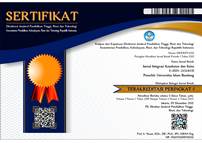Hubungan Karakteristik dengan Tingkat Pengetahuan Perempuan Usia Reproduktif mengenai Berat Badan Lahir Rendah dan Spektrum Plasenta Akreta pada Salah Satu Komunitas Perguruan Tinggi Swasta di Bandung
Abstract
Berat badan lahir rendah (BBLR) dan spektrum plasenta akreta (SPA) merupakan salah satu masalah kesehatan yang menyebabkan morbiditas serta mortalitas ibu dan janin yang signifikan. Pengetahuan tentang kesehatan sangat penting untuk mengurangi efek buruk tersebut. Penelitian bertujuan mengetahui tingkat pengetahuan perempuan usia reproduktif mengenai BBLR dan SPA. Studi potong lintang berbasis masyarakat tersebut dilakukan pada bulan Agustus 2021 pada 65 partisipan komunitas usia reproduktif pada salah satu perguruan tinggi swasta di Bandung melalui pengisian kuesioner yang telah tervalidasi. Analisis data menggunakan uji chi-square melalui perangkat lunak STATA versi 15 untuk mengevaluasi hubungan antara karakteristik partisipan dengan tingkat pengetahuan BBLR dan SPA. Hasil penelitian sebanyak 54% partisipan memiliki pengetahuan BBLR dan SPA itu cukup. Terdapat hubungan signifikan karakteristik pekerjaan (p=0,02) dengan tingkat pengetahuan BBLR dan SPA, sedangkan karakteristik usia (0,009), status pernikahan (0,24), dan pendidikan (0,2) tidak berhubungan dengan tingkat pengetahuan mengenai BBLR dan SPA. Terdapat beberapa faktor yang memengaruhi pengetahuan, seperti usia, pendidikan, sosial budaya, ekonomi, lingkungan, serta pekerjaan. Simpulan, pemberian stimulus berupa informasi seputar BBLR dan SPA melalui kegiatan sosialisasi yang berkesinambungan diharapkan dapat menjadi salah satu solusi untuk meningkatkan pengetahuan pada komunitas perempuan usia reproduktif
Abstract
Low birth weight (LBW) and placenta accreta spectrum (PAS) are health problems that cause significant maternal and fetal morbidity and mortality. Health knowledge is very important to reduce these adverse effects. This study aims to determine the level of knowledge of women of reproductive age about LBW and PAS. The cross-sectional community-based study was conducted in August 2021 on 65 participants of the reproductive age community at a private university in Bandung by filling out a validated questionnaire. Data analysis used the Chi-Square test by STATA software version 15 to evaluate the association between participant characteristics and knowledge level of LBW and PAS. The results showed that most of the participants had sufficient knowledge of LBW and PAS (54%). There was a significant relationship between job characteristics (p=0.02) and the level of knowledge of LBW and SPA, while the characteristics of age (0.009), marital status (0.24), and education (0.2) are not related to the level of knowledge of LBW and SPA. Several factors influence knowledge, such as age, education, socio-culture, economy, environment, and work. In conclusion, health education in the form of information about LBW and PAS through continuous counseling is expected to be one of the solutions to increase knowledge in the community.
Keywords
Full Text:
PDF (Bahasa Indonesia)References
Thomas JP, Raine T, Reddy S, Belteki G. Probiotics for the prevention of necrotising enterocolitis in very low-birth-weight infants: a meta-analysis and systematic review. Acta Paediat. 2017;106(11):1729–41. https://doi.org/10.1111/apa.13902.
WHO Global Nutrition Targets 2025: Low birth weight policy brief. Kotanya?: WHO; 2018.
Hartiningrum I, Fitriyah N. Bayi berat lahir rendah (BBLR) di Provinsi Jawa Timur tahun 2012–2016. J Biometrika Kependudukan. 2019;7(2):97–104. https://doi.org/10.20473/jbk.v7i2.2018.97–104.
Veena A, Nisha N, Debashish S, Nag PP, Mathur A. Placental morphology in low birth weight infants. J Evolut Med Dental Scie. 2014 July 21;3 Issue 29:8251–58. DOI: 10.14260/jemds/2014/3039.
Kandil MA, Sayyeda TM, Salaha A, Al Gilanyb NM. Maternal and neonatal outcomes of placenta accreta: a descriptive case series study. Menoufia Med J. 2019;32:368–74.
Cahlil A, Richard B, Phillips H, Robert M, Silver, Joseph R. Placenta accreta spectrum. Am J Obstet Gynecol. 2018;219(6):259–75.
Cunningham FG, Leveno KJ, Bloom SL, Spong CY, Dashe JS, Hoffman BL, dkk. William Obstetrics. Edisi ke-24. New York: McGraw-Hill Education; 2014. hlm. 804–8.
Kansouh AM, Eldin EM. Maternal outcomes after different surgical techniques in placenta accreta: a prospective study. J Med Scie Res. 2018;1:306–11.
Farquhar CM, Li Z, Lensen S, McLintock C, Pollock W, Peek MJ, dkk. Incidence, risk factors and perinatal outcomes for placenta accreta in Australia and New Zealand: a case–control study. BMJ open. 2017;7(10):e017713.
Pan X-Y, Wang Y-P, Zheng Z, Tian Y, Hu Y-Y, Han S-H. A marked increase in obstetric hysterectomy for placenta accreta. Chinese Med J. 2015;128(16):2189.
Untari S. Pengetahuan ibu tentang faktor penyebab terjadinya BBLR (berat badan lahir rendah) di Kabupaten Grobogan. J Ilmiah Kesehat. 2016 Sept;8(2):85–8.
Notoatmodjo, Soekidjo. Metodologi penelitian kesehatan. Jakarta: Rineke Cipta; 2012.
Budiman, Riyanto A. Kapita selekta kuisioner pengetahuan dan sikap dalam penelitian kesehatan. Jakarta: Salemba Medika; 2013.
DOI: https://doi.org/10.29313/jiks.v6i1.11816
Refbacks
- There are currently no refbacks.
Jurnal Integrasi Kesehatan dan Sains is licensed under a Creative Commons Attribution-NonCommercial-ShareAlike 4.0 International License.







.png)
_(1).png)




















